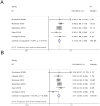Association between patatin-like phospholipase domain containing 3 gene (PNPLA3) polymorphisms and nonalcoholic fatty liver disease: a HuGE review and meta-analysis
- PMID: 25791171
- PMCID: PMC4366950
- DOI: 10.1038/srep09284
Association between patatin-like phospholipase domain containing 3 gene (PNPLA3) polymorphisms and nonalcoholic fatty liver disease: a HuGE review and meta-analysis
Abstract
We conducted a meta-analysis to assess the association between patatin-like phospholipase domain-containing 3 (PNPLA3) rs738409 polymorphism and nonalcoholic fatty liver disease (NAFLD) and its subtypes simple steatosis(SS) and nonalcoholic steatohepatitis (NASH). The study-specific odds ratios (ORs) and 95% confidence intervals (CIs) were calculated using fixed-effects or random-effects models, with assessment for heterogeneity and publication bias. Twenty-three case-control studies involving 6071 NAFLD patients and 10366 controls were identified. The combined results showed a significant association between NAFLD risk and the rs738409 polymorphism in all genetic models (additive model: OR = 3.41, 95% CI = 2.57-4.52; P < 0.00001). In addition, evidence indicated that the rs738409 polymorphism was significantly associated with NASH in all genetic models (additive model: OR = 4.44, 95% CI = 3.39-5.82; P < 0.00001). The subgroup and sensitivity analyses showed that these changes were not influenced by the ethnicities and ages of subjects or by the source of controls. The rs738409 polymorphism was only significantly associated with risk of simple steatosis in the allele contrast and had no effect in the other genetic models. These findings suggest that the rs738409 polymorphism in PNPLA3 gene confers high cross-ethnicity risk for NAFLD and NASH development.
Figures






References
-
- Angulo P. Nonalcoholic fatty liver disease. N Engl J Med 346, 1221–1231 (2002). - PubMed
-
- Browning J. D. et al. Prevalence of hepatic steatosis in an urban population in the United States: impact of ethnicity. Hepatology 40, 1387–1395 (2004). - PubMed
-
- Farrell G. C. & Larter C. Z. Nonalcoholic fatty liver disease: from steatosis to cirrhosis. Hepatology 43, S99–S112 (2006). - PubMed
-
- Ratziu V., Bellentani S., Cortez-Pinto H., Day C. & Marchesini G. A position statement on NAFLD/NASH based on the EASL 2009 special conference. J Hepatol 53, 372–384 (2010). - PubMed
-
- Powell E. E. et al. The natural history of nonalcoholic steatohepatitis: a follow-up study of forty-two patients for up to 21 years. Hepatology 11, 74–80 (1990). - PubMed
Publication types
MeSH terms
Substances
LinkOut - more resources
Full Text Sources
Other Literature Sources
Medical

